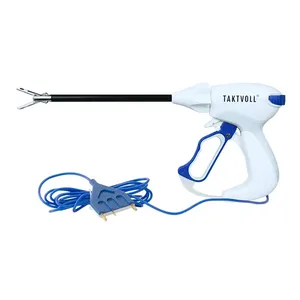
All categories
Featured selections
Trade Assurance
Buyer Central
Help Center
Get the app
Become a supplier

(81 products available)




























Harmonic instruments used in surgery are known for offering a high level of precision and efficiency. Below are the common types:
Harmonic Scalpel
A harmonic scalpels surgery device, also called ultrasonic surgical organ dissection and coagulation instruments, is a high-frequency (55 KHz) powered surgical instrument, which allows cutting and coagulating tissue simultaneously.
Harmonic Curved Blade
This blade is designed for a wide variety of tissue grasping and manipulation. Its curvature allows working with deep or shallow tissue layers. The blade oscillates at ultrasonic frequencies.
Harmonic Straight Blade
The harmonic straight blade, which is also called a linear blade, is designed for cutting soft tissue precisely. This blade's straight profile allows it to be primarily used in areas that are more accessible.
Harmonic Fork Grasper
The harmonic fork grasper is designed with two long, narrow prongs that fork into tissue for better visibility and grasping. It also has a thin profile that enables use in shallow surgical spaces.
Harmonic Paddle Grasper
This type of instrument is designed with two elongated, flat prongs, which efficiently grasping and manipulating tissue. The paddle shape provides a broad contact surface, which helps prevent crushing.
It is important to consider the following factors when selecting surgical devices for harmonic surgery:
The following instruments are commonly used when working with specific tissue types:
Coagulation needs depend on the specific procedure being performed. For instance, main vessels need strong coagulation.
There are many ways to approximate tissue thickness during surgery. The safest approximation is the use of ultrasound imaging. Tissue type, previous surgeries, and injuries may also change its thickness.
The surgeon's comfort level with specific tools and technologies is very important when choosing harmonic surgical instruments.
In many cases, the choice of instruments will depend on the type of surgery being performed. For instance, complex oncology procedures will sometimes need more specialized tools compared to routine laparoscopic surgeries.
The shape and contour of the tissue to be dissected may determine which tools will be most appropriate for any given procedure. One good example is when working in dense or irregularly shaped tissues. Traditional tools may sometimes offer better visibility than others.
It is important to consider the following maintenance and repair tips for surgical tools:
These instruments come with unique features, but they all have similar characteristics:
Below are the steps to take when replacing parts of these instruments:
Here is the product's name based on its function, benefit, features, and specification:
A1. Harmonic scalpels offer many benefits, including precise tissue dissection, which reduces damage to surrounding tissues. Their ability to simultaneously cut and coagulate minimizes bleeding, improving visibility during surgery. This leads to cleaner surgical sites and quicker recovery times; patients often experience less post-operative pain and swelling.
A2. Harmonic scalpel blades are typically made of stainless steel or titanium. They are chosen for their excellent biocompatibility, resistance to corrosion, and durability. These materials ensure that the blades withstand the high-frequency vibrations.
A3. Yes, harmonic scalpel blades require specific maintenance to ensure their longevity and functionality. After each use, blades should be thoroughly cleaned to remove any tissue debris.
A4. A harmonic scalpel uses ultrasonic waves to generateHigh-frequency vibrations from the handpiece create an oscillating motion at the tip. This tip movement is what cuts through the tissue. As the tissue is cut, the ultrasonic waves also transfer heat to the tissue.
A5. It is impossible to fully prevent sharpening blades. There are a few ways to prolong their durability. Regular cleaning after use will prevent residue from accumulating. Avoiding contact with hard surfaces can also prevent nicks and micro-damage. Proper sterilization techniques.